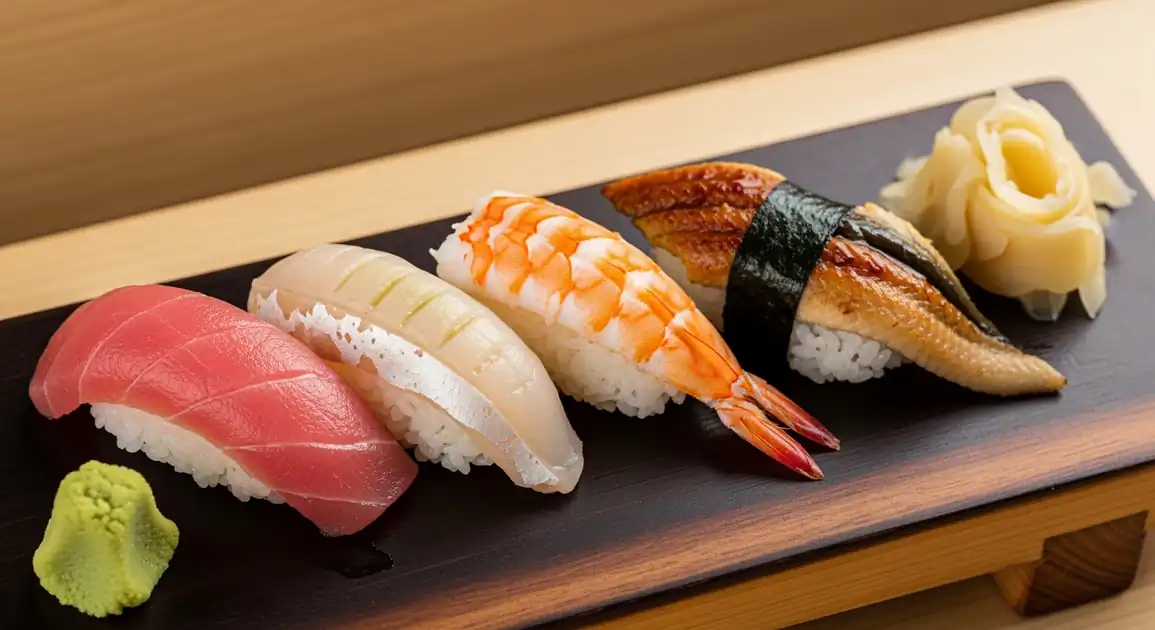Edomae Sushi
江戸前寿司 (Edomae-zushi)

Description
Tokyo is the birthplace and epicenter of Edomae sushi. The city boasts an unparalleled number of sushi restaurants, from legendary Michelin-starred counters in Ginza charging hundreds of dollars, to excellent neighborhood gems and stalls near the fish market. Tokyo sets the global standard for Edomae sushi.
Dietary Information
Serving information
Serving style
Counter service ('Omakase' or à la carte) is the classic Edomae experience. High-end places are almost exclusively counter. Sets and à la carte available at tables in mid-range places. Served piece by piece or as a set ('moriawase').
Quick facts
High-end: Often Dinner only, or limited Lunch seatings (5:30 PM - 10 PM). Mid-range/Market: Lunch (11 AM/11:30 AM - 2 PM), Dinner (5 PM/5:30 PM - 10 PM). Closures vary (Sun/Mon common).
Safety Tips
What to Look For
-
Reputable, specialized sushi restaurant ('sushi-ya')
Expertise in sourcing, handling, and preparing raw fish is paramount. Look for established places with good reviews or recommendations.
-
Visible freshness of ingredients ('neta')
Fish should look glossy, vibrant, and firm, not dull, dry, or discolored. Check the appearance of items in the display case (if applicable).
-
Impeccable cleanliness of the counter, utensils, and chef's hands
High hygiene standards are essential for raw food preparation. Observe the chef's practices.
-
Chef ('itamae') works skillfully and confidently
Proper technique minimizes handling time and ensures correct preparation, contributing to safety and quality.
-
Sushi rice ('shari') served at body temperature
This is the traditional way and indicates fresh preparation, contrasting with cold, pre-made sushi.
-
Good turnover of customers
Especially in mid-range or market settings, busy places suggest ingredients are fresh and move quickly.
What to avoid
-
Establishments with poor hygiene or low ratings/reviews
Avoid places that look unclean or have documented issues. Trust local review sites (e.g., Tabelog).
-
Fish that looks dull, dry, mushy, or discolored
These are clear signs that the fish is not fresh or has been handled poorly.
-
Strong 'fishy' or unpleasant odors
Fresh, high-quality seafood should smell clean like the ocean, not overtly fishy.
-
Pre-made sushi sitting out for extended periods
Unless from a very reputable source known for high turnover take-away, freshly made is always safer and better.
-
Suspiciously cheap prices for premium items (e.g., Otoro, Uni)
Extremely low prices can sometimes indicate compromised quality or sourcing.
Price information
Price range
Budget tips
- Seek out lunch sets, especially on weekdays (2000-5000 JPY).
- Explore restaurants outside prime districts like Ginza; areas like Shimbashi or local neighborhoods offer quality at lower prices.
- Visit the Tsukiji Outer Market for good value sushi breakfasts or lunches.
- Reputable Kaitenzushi chains offer a very budget-friendly introduction (1500-3000 JPY per person).
Value indicators
- Chef's reputation and skill.
- Use of high-quality, seasonal, and sometimes rare 'neta'.
- Perfectly seasoned and textured 'shari'.
- Atmosphere and personalized service, especially at counters.
- Reservations required often indicates high demand/quality.
Where to Find This Dish
Ginza
Home to many of the world's most famous and expensive sushi restaurants. Reservations essential, often months ahead.
Wako Building, Kabuki-za Theatre
Dinner, Lunch (pricier)
Tsukiji Outer Market
Despite the inner market moving to Toyosu, the outer market still thrives with many sushi restaurants and stalls offering fresh catches.
Tsukiji Hongan-ji Temple
Morning (breakfast), Lunch
Shimbashi / Yurakucho
Areas known for many good quality, often less formal or hidden sushi bars catering to office workers. Good mix of price points.
SL Square (Shimbashi), Tokyo International Forum (Yurakucho)
Lunch, Dinner
Residential Neighborhoods (e.g., Sugamo, Asagaya)
Can find excellent, long-standing local sushi-ya often run by veteran chefs, offering great value and a local atmosphere.
Local shopping streets ('shotengai')
Lunch, Dinner
Vendor Tips
- Book high-end Ginza restaurants far in advance, sometimes through hotel concierges or dedicated booking services.
- For Tsukiji, arrive early, especially on weekends, as popular places have long queues.
- Specify if you don't want wasabi ('wasabi nuki') when ordering if needed (though the chef usually applies the correct amount).
- Don't hesitate to try Omakase even at mid-range places; it's often the best way to experience their offerings.
How to Order
Regional Variations
-
Focus on Tuna (Maguro)
(マグロへのこだわり)
Tokyo restaurants, especially high-end ones, often place significant emphasis on sourcing and serving various cuts of premium tuna.
-
Akazu Rice
(赤酢シャリ)
Use of red vinegar ('akazu'), made from sake lees, for the sushi rice is a traditional Edomae characteristic often found in more traditionalist Tokyo shops, giving the rice a brownish hue and distinct flavor.
-
Aging Fish (Jukusei)
(熟成魚)
Some modern high-end Tokyo chefs experiment with aging fish for specific periods to develop umami and alter texture, a technique applied alongside traditional Edomae methods.
Cultural context
History
Emerging in the Bunsei era (early 1800s) near the fish-rich Tokyo Bay ('Edo-mae' means 'in front of Edo'), Edomae sushi began as fast food sold from street stalls. Techniques like curing fish with salt and vinegar or simmering in soy-based broth were vital preservation methods before refrigeration. Over time, it evolved from street food into the refined counter ('sushi-ya') experience known today, preserving meticulous preparation methods and emphasizing the connection between the chef ('itamae') and the customer.
Local significance
Edomae sushi is a defining element of Tokyo's culinary identity, representing tradition, craftsmanship, and the city's historical connection to the sea. It's a source of immense civic pride.
Eating customs
- Observing counter etiquette is particularly important in Tokyo's serious sushi establishments.
- Conversation with the chef is possible if they are not too busy, enhancing the experience.
- Paying attention to the sequence and explanation (if given) of each piece shows respect.